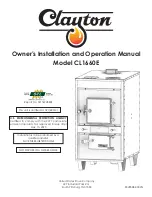
66
13. Remove manometer from the inlet pressure tap of the gas
valve.
FIRE HAZARD
Failure to follow this warning could result in personal injury,
death, and/or property damage.
Inlet pressure tap set screw must be tightened and 1/8
−
in. NPT
pipe plug must be installed to prevent gas leaks.
!
WARNING
14. Tighten set screw on inlet tower pressure tap with 3/32
−
in.
hex wrench, or if 1/8
−
in. NPT plug was removed, apply
pipe dope sparingly to end of plug and re
−
install in the gas
valve.
Adjust Manifold Pressure
NOTE
: There are two manifold pressure tables in these
instructions, see Table 22.
1. Adjust manifold pressure to obtain proper gas input rate.
See Fig. 60.
a. Refer to the correct manifold pressure table for the appro-
priate model.
a. Turn gas valve ON/OFF switch to OFF.
b. Loosen set screw on manifold tower pressure tap no
more than one full turn with a 3/32
−
in. hex wrench, or
remove the 1/8 inch NPT plug from the manifold pres-
sure tap on the gas valve.
c. Connect a water column manometer or similar device to
manifold pressure tap.
d. Turn gas valve ON/OFF switch to ON.
e. Manually close blower door switch.
f. Jumper R and W thermostat connections on control to start
furnace. See Fig. 40.
g. Remove regulator adjustment cap from gas valve pressure
regulator and turn adjusting screw (3/16 or smaller flat
−
tipped screwdriver) counterclockwise (out) to decrease in-
put rate or clockwise (in) to increase input rate. See Fig.
DO NOT set manifold pressure less than 2.8
−
in. W.C. (697
Pa) or more than 3.8 in. W.C. (947 Pa) for natural gas. If
required manifold pressure is outside this range, change main
burner orifices to obtain manifold pressure in this range.
NOTICE
h. When correct input is obtained, replace cap that conceals
gas valve regulator adjustment screws. Main burner flame
should be clear blue, almost transparent See Fig. 69.
i. Remove jumper R to W.
NOTE
: Contact your HVAC distributor or gas supplier for metric
gas meter Tables, if required.
2. Verify natural gas input rate by clocking meter.
a. Turn off all other gas appliances and pilots served by the
meter.
b. Jumper R to W.
c. Run furnace for 3 minutes.
d. Measure time (in sec) for gas meter to complete one revolu-
tion and note reading. The 2 or 5 cubic feet dial provides
a more accurate measurement of gas flow.
e. Refer to Table 21 for cubic ft. of gas per hr.
f. Multiply gas rate cu ft./hr by heating value (Btuh/cu ft.) to
obtain input rate. If clocked rate does not match required
input from Step 1, increase manifold pressure to increase
input or decrease manifold pressure to decrease input. Re-
peat steps b through e of Step 1 until correct heat input is
achieved. Re
−
install regulator seal cap on gas valve.
3. Restore furnace to normal operating condition.
a. Turn gas valve ON/OFF switch to OFF.
b. Remove water column manometer or similar device from
manifold pressure tap.
c. Tighten set screw on manifold tower pressure tap with
3/32
−
in. hex wrench, or if 1/8
−
in. NPT plug was removed,
apply pipe dope sparingly to end of plug and reinstall in
the gas valve.
d. Turn gas valve ON/OFF switch to ON.
e. Check for gas leaks and verity furnace operation.
FIRE HAZARD
Failure to follow this warning could result in personal
injury, death, and/or property damage.
Manifold pressure tap set screw must be tightened and
1/8
−
in. NPT pipe plug must be installed to prevent gas
leaks.
!
WARNING
Adjust Temperature Rise
NOTE
: Blower door must be installed when taking temperature
rise reading. Leaving blower door off will result in incorrect
temperature measurements, due to possible changes in duct static
pressure and airflow.
FURNACE DAMAGE HAZARD
Failure to follow this caution may result in:
Overheating the heat exchangers or condensing flue gases
in heat exchanger areas not designed for condensate.
Shortened furnace life.
Component damage.
Temperature rise must be within limits specified on furnace
rating plate. Recommended operation is at midpoint of rise
range or slightly above.
CAUTION
!
Jumper R to W to check gas
−
heat temperature rise. Do not exceed
temperature rise ranges specified on unit rating plate.
This furnace must operate within the temperature rise ranges
specified on the furnace rating plate. Determine the air temperature
as follows:
1. Place duct thermometers in return and supply ducts as close
to furnace as possible. Be sure thermometers do not “see”
heat exchangers so that radiant heat does not affect
thermometer readings. This is particularly important with
straight run ducts.
2. When thermometer readings stabilize, subtract return
−
air
temperature from supply
−
air temperature to determine
temperature rise.
If the temperature rise is outside this range, check the following:
1. Gas input rate.
2. Derate for altitude, if applicable.
3. Return and supply ducts for excessive restrictions causing
static pressures greater than 0.50
−
in. W.C. (125 Pa)
4. Adjust temperature rise by adjusting blower speed.
Increase blower speed to reduce temperature rise.
Decrease blower speed to increase temperature rise.
912S
















































